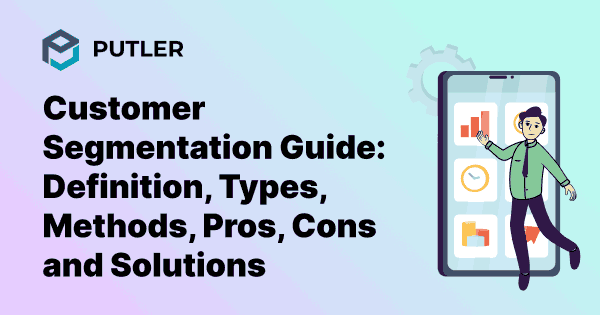Imagine pitching premium products to customers who hardly visit my store. Will that help? Of course, this won’t.
Consider a female customer X with a history of purchasing cosmetics. If I notify her about men’s accessories, will it generate leads?
It doesn’t. In fact, you will only shoot up the marketing expenses with minimal or no returns.
This is where the idea of customer segmentation analysis peeps in. This guide is specifically designed to educate you on customer segmentation and how it helps optimize your marketing efforts.
Let’s get started.
What is customer segmentation?
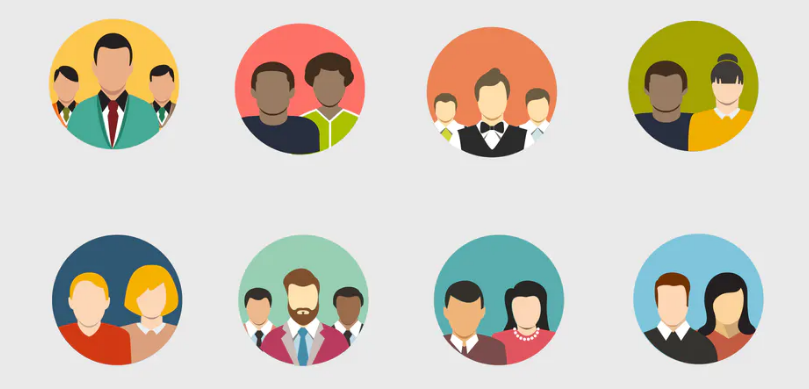
In simple terms, customer segmentation is the process of dividing customers into groups based on certain factors.
This means that customers with similar characteristics or exhibiting similar purchasing behavior are grouped together.
The sole purpose behind such segmentation or customer division is to improve the norms of marketing, thereby personalizing the entire process.
Customer Segmentation can be done in a number of ways, and adopting multiple approaches is beneficial.
Let’s dig deeper into these approaches / methods.
What are the methods for carrying out customer segmentation?
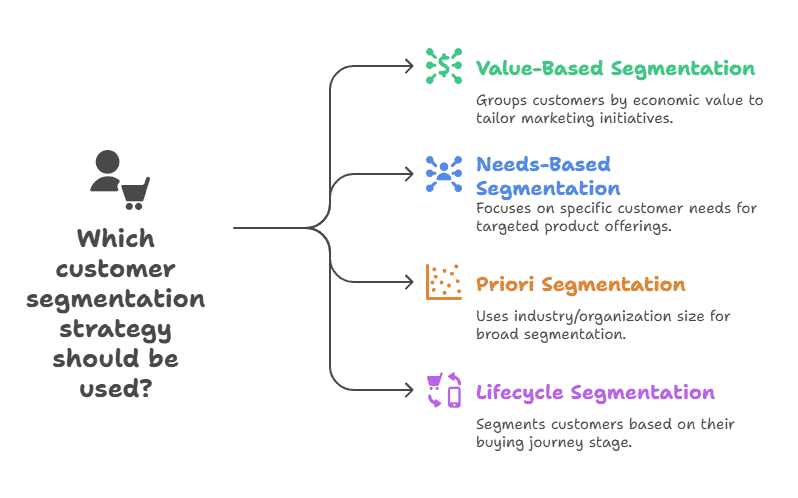
Here are some key ways to effectively segment your customers.
Segmenting by value
As specified by the term, value-based segmentation is differentiating customers with respect to their economic value. Users with similar economic standings would be grouped, and marketing initiatives would be targeted accordingly.
Segmenting by needs
This demarcation is based on specific needs as expressed by the customers for a particular product. For instance, customers who show interest in buying a particular product during a specific time are segmented into a certain group.
Priori segmentation
Suppose you are looking for something more generic and on a broader basis. In that case, priori segmentation is one of the simplest forms of customer segmentation analysis and is based on the size of the industry / organization.
Lifecycle segmentation
Lifecycle segmentation is a way businesses group their customers based on where they are in their buyer’s journey.
Think of it like this: some people are just learning about a product, others are considering buying it, and some have already made a purchase and might buy again.
Let’s break it down and see how you can give each customer exactly what they need when they need it.
New customers
These customers have just made their first purchase. They’re excited but maybe a bit unsure about your brand.
What’s your strategy? Give them a warm welcome. Guide them through everything, make them feel valued, and establish trust.
Active customers
These are your regulars. They love what you’re selling and keep coming back for more.
What’s your strategy? Keep that spark alive. Encourage them to explore more of your offerings and turn them into loyal customers.
At risk customers
These customers are showing signs of abandoning you. Their purchases are slowing down, and your emails are gathering dust in their inbox.
What’s your strategy? Launch a full-scale outreach campaign. Re-engage them before they slip away.
Churned customers
These customers have gone missing. No purchases, no engagement, nothing.
What’s your strategy? Go for the grand gesture. Create a killer win-back campaign and give them an offer they can’t refuse.
Loyal customers
These are your superstars, your ride-or-die fans. They don’t just buy your products, they recommend your brand to anyone who will listen.
What’s your strategy? Make them feel like royalty. Give them the VIP treatment and opportunities to spread the love.
Remember, customer lifecycle segmentation isn’t a set-it-and-forget-it deal. Watch for changes in behavior and be ready to adjust your approach.
Following a similar analogy, the customer segmentation process could include the following base factors:
What are the common types of customer segments?
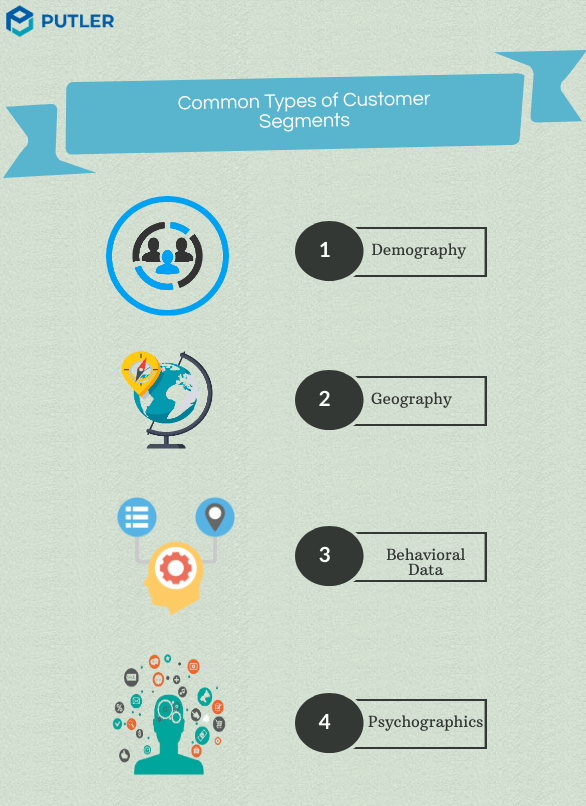
Demography
Segmentation of customers based on their age, occupation, gender, income, etc, is demographic demarcation. Imagine having a separate group of customers who are females aged 18-28. Separate marketing strategies are used to target each of the groups.
Geography
This is the line drawn between people belonging to the state / city/ region/ country.
Behavioral data
Such differentiation is primarily driven by the purchase patterns and spending behaviors of customers. There will be a few who are more inclined towards premium products, whereas some would always look for the cheapest products. Tracking these patterns with user behavior analytics helps in identifying trends and creating highly targeted campaigns.
Psychographics
Psychographical segmentation is described based on the lifestyle and personality of people. Imagine a few ordering organic products frequently. So, your store can then have a well-personalized marketing strategy to target customers belonging to a particular segment.
These are the basics; see our full guide to customer segments for more examples and ideas.
Now, knowing all the methods of executing customer segmentation is fine, but how does that help you in business? Let’s find the answer to that.
How segmentation saves marketing efforts / costs and generates high ROI
With that being said, the questions that arises here are:
- Why is it important to have customer segmentation analysis?
- How does the method affect marketing efforts?
It is pretty clear by now that customer segmentation is all about grouping your customers in a way that ones with similar characteristics lie under the same segment. Once done, the marketing team can then draft plans and marketing strategies specific to a particular group.
For example
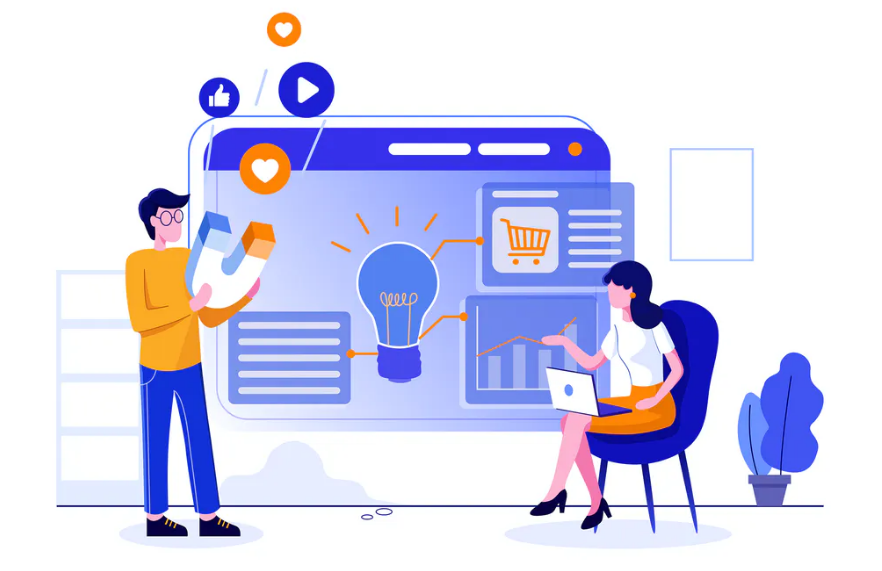
Suppose that you have planned to advertise an end-of-season sale with hefty discounts on books and related items.
Now, instead of pitching the offer to all customers, you can leverage the groups you’ve created.
An in-depth customer segmentation analysis would help you identify customers who are frequent buyers or have made a purchase at some point.
Specific deals and customer-based offers can be created to target the customers.
Not to forget that targeting the right product to the right customer leads to better sales. It’s like giving them what they want.
Benefits of customer segmentation
Here are the benefits of customer segmentation.
- Improving your whole product: Customer segmentation helps you better understand your customers and their needs. You can apply this learning to improve your product and increase the satisfaction level of both your existing and new customers.
- Improving marketing message: Similar to improving the product, customer segmentation also helps you laser target your marketing messages and, in the bargain, increases conversions.
- Allowing your sales teams to perform better: By understanding your customer segments, your marketing team can easily create strategizes for them. Customer segmentation provides marketers with all the information they need to pitch products, create sales pages, write emails, etc, and they no longer need to resort to trial and error. This not only saves time, energy, and money but also leads to an increase in profits and revenue.
Summarizing the above, consumer-based marketing helps personalize the offerings, driving higher sales and boosting results.
Want to dig deeper into what your customers really want? Check out our guide to customer insights.
Real-world examples and case studies
Want to see how big brands are crushing it with customer segmentation?
Let’s dive into some exciting examples that’ll make you say, “Wow, I need to try this.”
Nike
Ever wondered how Nike always seems to know what you need? It’s not magic, it’s segmentation. Here’s how they do it:
- They group customers based on fitness levels, favorite sports, and shopping habits.
- Nike’s apps (like Nike Run Club) are treasure troves of user data.
- They create personalized product suggestions and workout plans.
How Nike puts this into action:
- Tailored emails for different athlete types (runners get different content than basketball players).
- Personalized in-app challenges that keep you motivated.
- Product launches that speak directly to specific customer groups.
Results:
- Nike Plus membership shot up by 30%.
- Users are way more engaged with Nike’s digital platforms.
- Personalized product recommendations are scoring higher sales.
Grammarly
Grammarly ensures your writing is on point by using segmentation. Check out their strategy:
- They group users based on writing style, how often they use the tool, and common mistakes.
- They look at what users are trying to achieve (essay or work email?).
- They pay attention to which features users love most.
Grammarly’s game plan:
- Weekly writing reports that show you where you can improve.
- Suggesting premium features that’ll solve your specific writing woes.
- Emails that feel like they were written just for you.
The results?
- More free users are leveling up to premium.
- Users are sticking around and using Grammarly more often.
- They’re selling more premium features by showing users exactly what they need.
Airbnb
Airbnb’s not just finding you a place to crash, they’re curating your entire travel experience. Here’s how they’re nailing it with segmentation:
- They group travelers based on their preferences, booking history, and search behavior.
- They analyze host data to create property segments.
- They take a good, hard look at those user reviews and ratings.
Airbnb’s master plan:
- Personalized property suggestions that make you go, “That’s exactly what I was looking for.
- Travel guides and experiences tailored to your interests (foodies, adventure seekers, history buffs – they’ve got you covered).
- Pricing suggestions for hosts based on their property type and location.
The results?
- More bookings thanks to spot-on recommendations.
- Travelers are loving (and booking) those personalized Airbnb Experiences.
- Hosts are happier and stick around longer.
Want results like this? Try behavioral segmentation.
Why is RFM the preferred customer segmentation method?
Irrespective of the type of business you are in and the marketing plan adopted, a single factor for segmenting customers isn’t right. It could happen that you have a customer who made a high-value purchase. If you segment customers based on the monetary pricing, he/she might rank first.
What if the purchase was made long ago and is the only one made? Will targeting the customer help you? Odds are you won’t even get a click open rate. Hence, the RFM method.
RFM stands for
- Recency: When was the last purchase made?
- Frequency: How often does the customer buy from you?
- Monetary: What’s the value of the goods purchased?
Read more about RFM segmentation
This is the best way to segment customers as it considers all the important parameters like recency, frequency, and monetary value before categorizing customers into various groups.
Now that we know the best segmentation strategy let’s look at how to do it practically.
Difficulties in doing segmentation manually

Although all of this seems easy, it is actually packed with challenges and bottlenecks.
- No matter how efficient your calculations are, technical errors or data irrelevance may still arise.
- It might so happen that the data you have is months old and valueless today.
Carry out customer segmentation within seconds using Putler
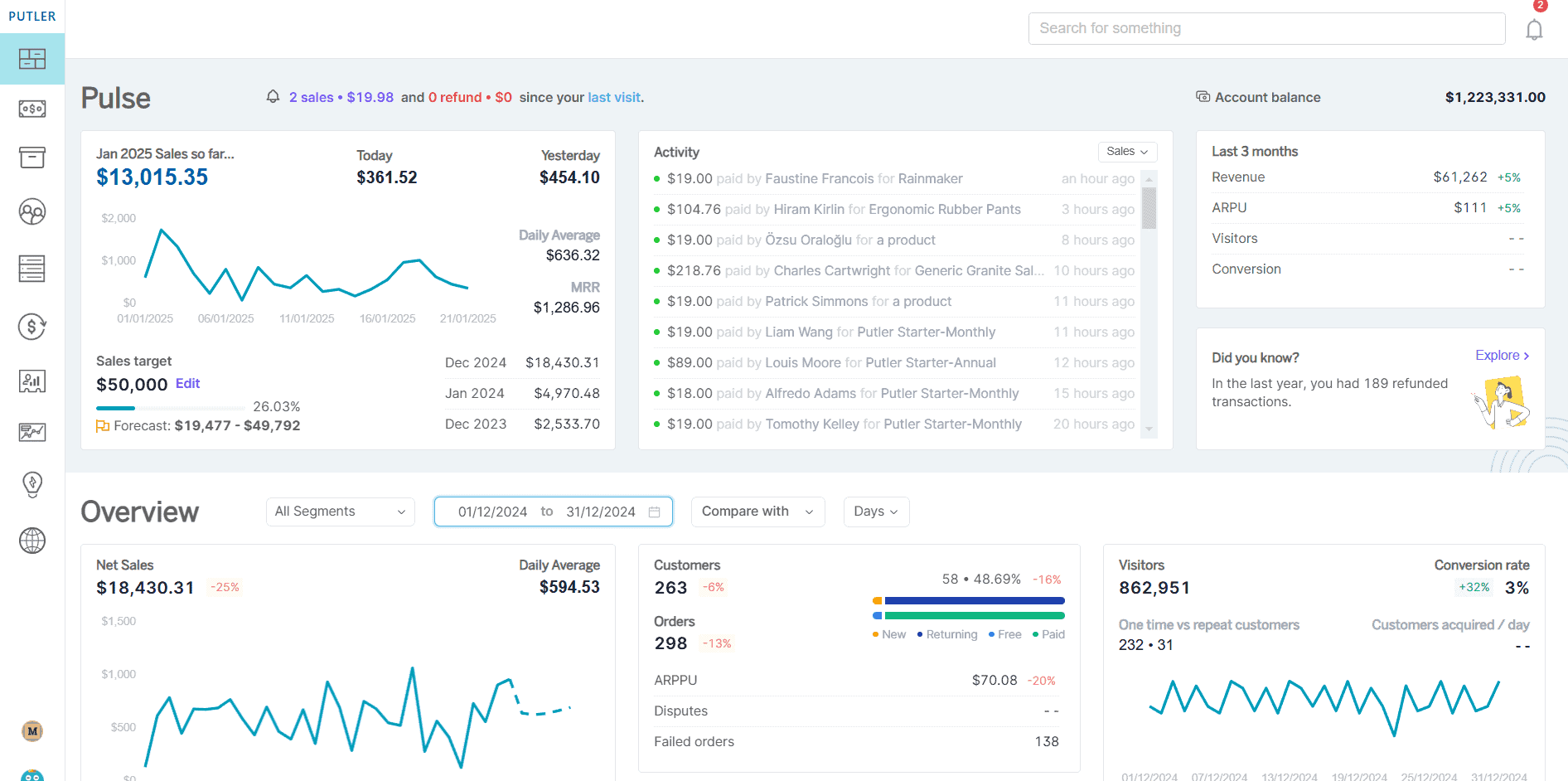
When you are a business owner and have thousands of customers, segmenting them manually would do no good.
Here comes the role of Putler in the picture.
As a business owner with thousands of customers, manually segmenting them would be ineffective.
Here comes the role of Putler in the picture.
A dedicated RFM analysis and segmentation tool, it helps you set up different rules and charts to find your best value customers. It has an intuitive dashboard that helps you select the period for which you wish to have the chart displayed.
But is it just the RFM factors that can be used? How about segmentation based on geography, product, or price?
Customer segmentation examples: How does Putler help segment customers?
Segment based on shopping behavior
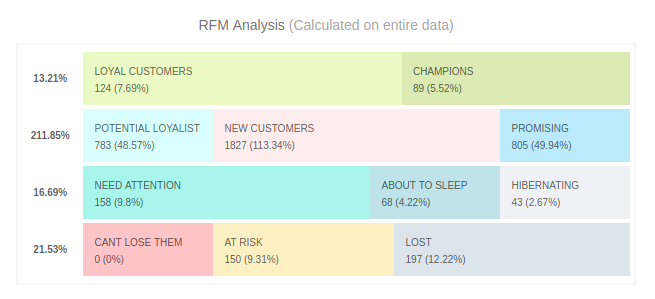
Ever needed to export a list of customers segmented by their shopping behavior for targeted marketing campaigns? Then Putler’s RFM segmentation is the best for you.
Imagine the loads of work you need to do when pitching email marketing campaigns. Don’t worry. Putler cuts the whole process and comes up with an optimized approach. For instance, if you have come up with some exciting holiday season sales and offers, Putler allows you to have a high-end view of the figures and conversion rates, so you can determine which segment to target and how.
For example
Putler is already integrated with your eCommerce store and payment gateways. It segments your customers based on how recently they bought from your store, how frequently they buy, and the monetary value they have contributed to your store to date.
All you need to do is design the email marketing content and either send the targeted RFM segment email direclty from Putler or export the segment and send them an email from your ESP.
No more spreadsheets. No more manually segmenting. No more hassles.
You simply concentrate on strategies, reducing churn and increasing your revenue.
Cool right? Let’s go to the next form of segmentation that Putler provides…
Product based segmentation
Nothing to worry about, as Putler offers an easy-to-use dashboard that lets you easily locate customers who have purchased similar products!
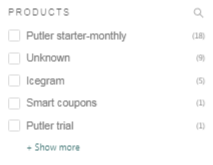
For example
Suppose you need to send emails to customers who purchased a mobile phone in, say, the last three months.
All you need to do is visit the dashboard, filter results for the last month, and then search for the product.
The results generated would display customers who have purchased the product within the specified time span. Easy, right?
Geography based segmentation
Pitch products based on the location of the customers.
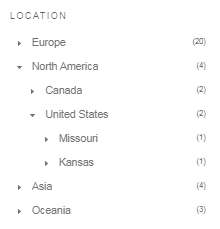
For example
Suppose that you are planning to have a special offer for the 4th of July. Now, this has to be targeted only to the customers of the US. In case you follow the conventional method, it would be pitched to all. Hence, Putler.
The Putler dashboard gives you the ease to segment customers based on location. You can visit the page, filter results by location, and then target your email offer to the generated list.
Price based segmentation
Another fine example of using Putler is pitching products based on their price.
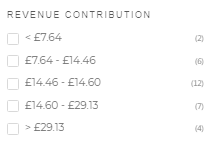
For example
Imagine hosting email campaigns for higher-priced products, such as a laptop, a fridge, or an iPhone.
With the help of Putler, you can run a search operation based on the price range.
The platform would filter the names of all those who have purchased within the specified price range.
With the list of your premium customers, you’re all set. Not to mention, such segmented targeting yields better results and higher sales.
6 Practical ways to use customer segmentation in business
Now that you know how Putler helps you segment customers based on different parameters (easily), here are some ways you can actually use the customer segments.
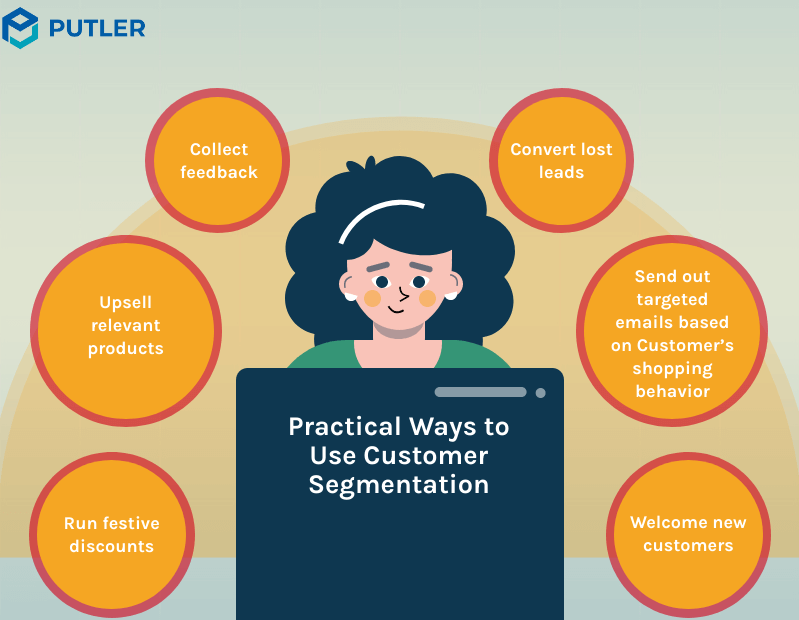
Send out targeted emails based on customer’s shopping behavior
For this, we will use Putler’s RFM segmentation. The reason being – RFM segments customers based on their buying behavior.
You could send out multiple targeted emails like:
- Send out time-limited discount coupons for people who are in the hibernating segment and tempt them to make a purchase
- Send out store credits to segments that are at risk of losing customers, such as those who are about to go to sleep.
- Build better customer relationship with your loyal, champion segment.
Collect feedback
Feedback is always a great way to get some valuable insights from your customers. You can collect feedback from two segments: New Customers and Customers who asked for a refund.
- New customers – You can easily find out your new customers by going to Putler’s Customer Dashboard and selecting the Customer Type Filter as New. Remember to keep the date period as 90 days. Send a feedback email to all customers who have been with you for at least 30 days.
- Refunded customers – For this, go to Putler’s Sales dashboard and select the Status filter as Refund. Send them an email asking them about the reason for the refund. Hear out their concerns and find a way to address them.
Convert lost leads
By lost leads, I mean customers whose subscription has gone into the Failed state. You can find this segment within the Transactions Dashboard and select the Status filter to Failed. You can send them the steps to reinitiate their subscription and in the bargain close some more sales.
Run festive discounts
For this, you can use the location-based segmentation within Putler. You can go to the Sales Dashboard, select the Location filter for whichever country has a festival coming up. Select Ireland and send a festive discount to all your customers from Ireland during St. Patrick’s Day.
Upsell relevant products
Suppose you have a new, improved variant of product A or a complementary product to it. Go to the Customers Dashboard, select the Product filter as A, and send an upsell email to everyone who has purchased product A. Since it is a relevant upsell, there are chances that your segment will purchase the new offering. Thus increasing sales.
Welcome new customers
Similar to feedback emails, you can send out Welcome emails to new customers who have just joined your business. Again go to the Customer’s dashboard, select type a New and keep the period as a week / month and send out welcome emails to the new customers.
Conclusion
Customer Segmentation is not a one-time process but a long journey and a repetitive one.
’Customer buying behavior is constantly evolving, and to fully realize the process’s potential, itis essential to continually refine your segmentation list and tailor customer interactions based on various factors.
FAQs
What is customer segmentation?
Customer segmentation is like sorting your closet but for your customer base. It’s the process of dividing your customers into groups based on shared characteristics.
By grouping individuals with similar traits, you can customize your strategies and communications to meet the specific needs of each group.
It’s all about understanding your customers better so you can give them exactly what they want when they want it.
How do I measure the success of my segmentation strategy?
Measuring the success of your segmentation strategy is like checking your fitness progress. You need to keep track of key metrics. Here are some numbers to watch:
- Conversion rates: Are your targeted campaigns hitting the mark?
- Customer Lifetime Value (CLV): Are your segments becoming more valuable over time?
- Engagement rates: Think email opens, click-throughs, and social media interactions.
- Overall revenue and profitability: Because at the end of the day, it’s all about the bottom line.
If these numbers are trending up, break out the champagne, your segmentation strategy is working.
What tools can I use for customer segmentation?
When it comes to customer segmentation tools, there are many options. Here are a few popular choices:
- Google Analytics: It’s great for understanding your website visitors’ behavior and can help you segment based on demographics, interests, and online activity.
- Mailchimp: Mailchimp offers robust segmentation features that let you segment subscribers based on their engagement, purchase history, and more.
- Hubspot: Another all-in-one marketing platform that offers powerful segmentation tools, allowing you to create highly targeted lists for your marketing campaigns.
- Putler: Segmenting customers in Putler is so much easier. It offers RFM analysis which automatically segments your customers. But that’s not all, Putler also comes with a treasure trove of filters. With Putler, you can sort customers by location, refund rates, quantity sold, and much more with just a click.
How often should I update my customer segments?
A good rule of thumb is to review and update your segments every 3-6 months. But remember, this isn’t a one-size-fits-all answer. If you’re in a fast-paced industry or notice sudden shifts in customer behavior, you might want to check in more frequently.
